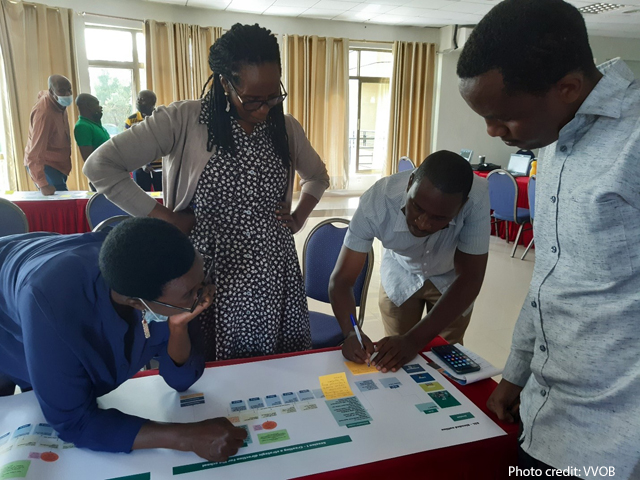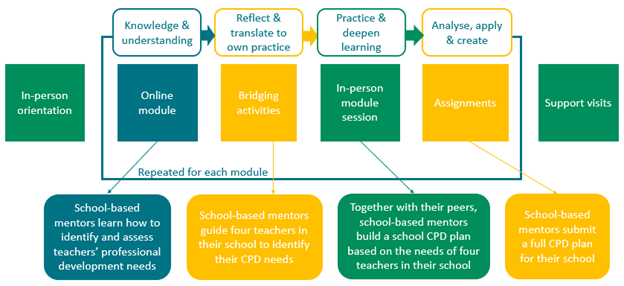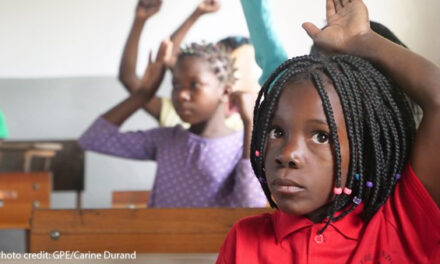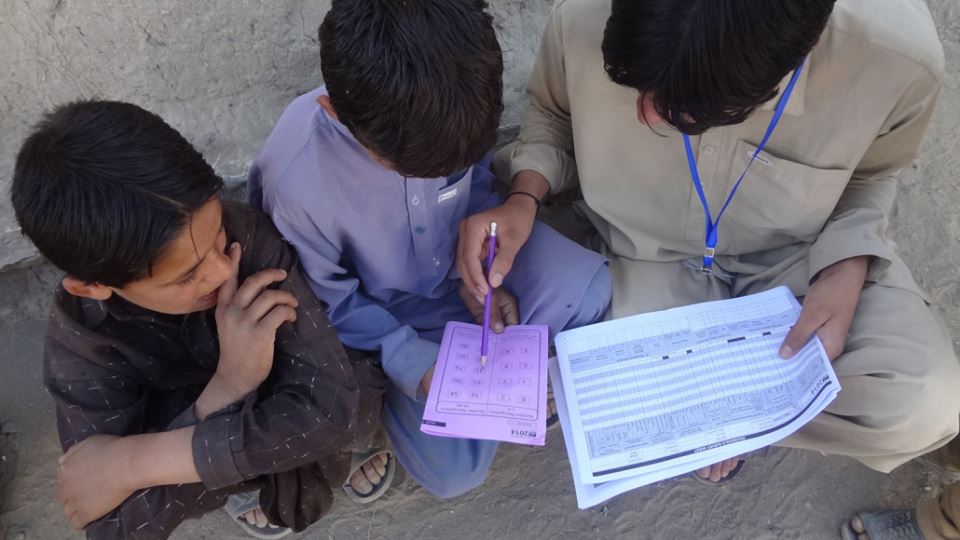This article was written by Loran Pieck and Lieve Leroy, Strategic Education Advisors with VVOB in Rwanda.
VVOB – education for development and government and university partners in Rwanda have been invested in strengthening educational leaders through professional development for years. Fixed practices were challenged when COVID-19 forced us all indoors, and in-person sessions were translated to online ones. Now, insights show how a well-thought-out fusion of in-person and remote activities can foster learning for all, reduce costs and catalyse the government’s digital transformation plans.
The big move to online learning
Since 2018, school leaders and teachers in Rwanda have the opportunity to engage in accredited continuous professional development (CPD) programmes developed and organised by the University of Rwanda – College of Education (URCE), Rwanda Basic Education Board (REB) and VVOB. Initially offered in-person, the programmes underwent a quick digital transformation when the pandemic hit.
This new mode of learning was largely the result of sudden COVID-19 restrictions, without taking advantage of the instructional benefits of integrating both modes of in-person and remote learning. But some two years later, in 2022, the original partners and the National Examination and School Inspection Authority (NESA) have conscientiously re-designed the blended delivery approach of two accredited CPD programmes: one on Effective School Leadership (ESL) and one on Educational Mentorship and Coaching (EMC).
The re-development was informed by two factors: the learning outcomes and pedagogical principles of each CPD programme; and the scalability of their delivery approach.
Instructional design model for blended CPD
The underpinning pedagogy of the CPD programmes upholds the following principles:
- competence-based learning
- a sense of community
- critical reflection.
These principles make the CPD programmes relevant to the practice of participants and go beyond the transfer of knowledge.
The delivery method of these programmes is based on a thoughtful fusion of remote and in-person learning activities connected by bridging activities. This combination allows for a staggered learning approach based on the flipped classroom.
- Each CPD programme starts with an in-person orientation session to introduce participants to the purpose and delivery approach of the programme. Moreover, such in-person orientation sessions offer the opportunity to build relationships.
- After this introductory in-person session, participants engage in interactive online course content. In this component, participants gain new knowledge and understanding on the topics of the CPD programme through interactive, authentic, memorable, social and accessible online courses.
- At the end of each unit in the online module, bridging activities are introduced. Such bridging activities offer participants the opportunity to start reflecting on the content of the module and to translate the content to their own work practice.
- After the online component of the module, participants go to an in-person session to practice the content with their peers and to deepen their learning about the content of the module.
- At the end of a module, participants submit assignments in which they analyse the content, apply it to their work practice and create an output which illustrates their learning.
These assignments are the end product of a staggered learning approach which starts through knowledge activities during the online component (2), becomes more applied through bridging activities (3), and gets enriched during an in-person session (4). This approach creates multiple opportunities for feedback and adjustments. All learning, at different levels of Bloom’s taxonomy, culminates in the assignment. Bloom’s taxonomy (2001) offers a hierarchical classification of various levels of thinking when developing course objectives. These levels are all lying along a continuum from simple to complex and concrete to abstract: remember, understand, apply, analyse, evaluate and create.
Twice during the programme, a support visit is organised to participants’ schools. The first visit is a coaching and support visit to help participants implement their learning in their daily activities. The second visit is organised towards the end of the programme to assess the application of competences acquired.
This fundamental change in the blended design of the CPD programmes allows scaffolding at each step in the learning of participants. Instead of substituting both modes of learning informed by prevailing COVID-19 measures, both modes are now integrated as a coherent whole and the potential of each mode of learning is maximised to create a meaningful learning experience for participants.
|
Practical example of a staggered approach using bridging activities In Rwanda, school-based mentors have the responsibility to guide the CPD of teachers in the school, by creating a school CPD plan. An intended learning outcome of the CPD-EMC programme is for school-based mentors to develop an effective CPD plan for their school. They do this step by step over each building block of the blended CPD programme:
Assignment: school-based mentors develop and submit a full CPD plan for their school. |
Designing for scale
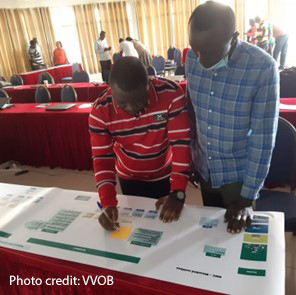 This re-design also offers opportunities to reduce the implementation cost to run these CPD programmes at scale. The sustainability of the CPD programmes largely depends on their delivery costs. When each component of the blended CPD programme is developed, the implementation cost of the online component (electricity and data) becomes cheaper than the cost of the in-person sessions (travel and accommodation). In the re-design of the blended CPD programmes, the development team therefore decided to reduce the number of in-person sessions and to introduce course content through an interactive online course. A study is needed to understand if this new design is as effective, and more cost-effective.
This re-design also offers opportunities to reduce the implementation cost to run these CPD programmes at scale. The sustainability of the CPD programmes largely depends on their delivery costs. When each component of the blended CPD programme is developed, the implementation cost of the online component (electricity and data) becomes cheaper than the cost of the in-person sessions (travel and accommodation). In the re-design of the blended CPD programmes, the development team therefore decided to reduce the number of in-person sessions and to introduce course content through an interactive online course. A study is needed to understand if this new design is as effective, and more cost-effective.
The shift to digital transformation is high on the agenda of the Ministry of Education. By participating in blended CPD, educational leaders experience the potential of this digital transformation as first-row participants and are therefore more likely to integrate ICT in teaching and learning in the school. The pandemic and rapid shift to online learning revealed and accelerated digital learning opportunities.
How to ensure that everyone is on board with this digital transformation
For many educational leaders, these CPD programmes are their first experience with blended learning. Facilitators on URCE’s side too need to settle in their new role as online learning and active in-person facilitators. It is important to prepare both before the blended CPDs start.
- Participants follow a four-week training in which they acquire the digital skills needed to effectively learn online. URCE facilitators of the blended CPD programmes follow an e-tutoring course to become skilled online learning facilitators.
- URCE facilitators learn how to engage participants in enriching and meaningful in-person activities that help them to apply the content at a deeper level. To do so, facilitators need to identify participants’ learning gaps by analysing their online learning progress.
- Facilitators also play an important role in nurturing participants’ motivation to actively engage with all components of the blended CPDs. This requires facilitators to act as facilitators of learning, rather than lecturers of content.
As a next step, this new instructional design model for blended CPD will be rolled out over four cohorts with over 1,500 participants in the two re-designed CPD programmes combined. Adjustments will be made through an iterative design process, based on monitoring data. Participants’ learning and facilitators’ roles will be closely supported and monitored to create an inclusive and contextualised delivery model which can be scaled across the country.
Are you a (PhD) researcher, or part of a research or EdTech organisation; and did this article spark your interest? VVOB and its partners are looking for organisations to collaborate on researching and further strengthening the CPD design. Please reach out to the authors of this article (Loran.Pieck@vvob.org; Lieve.Leroy@vvob.org) for more information.

